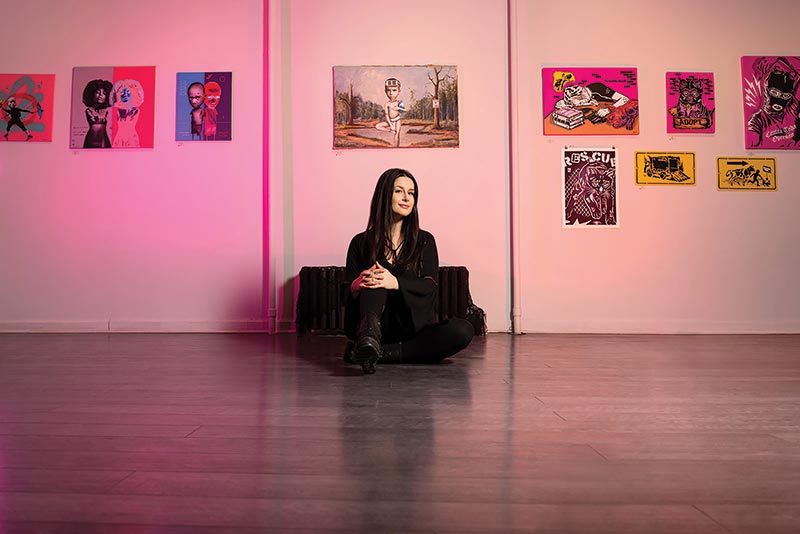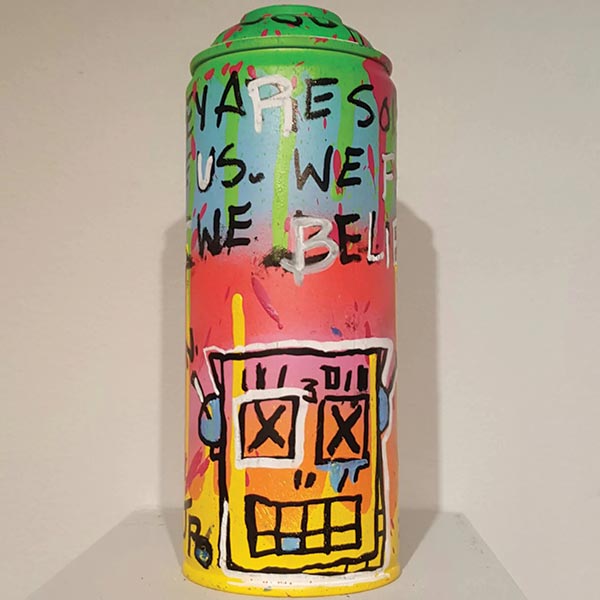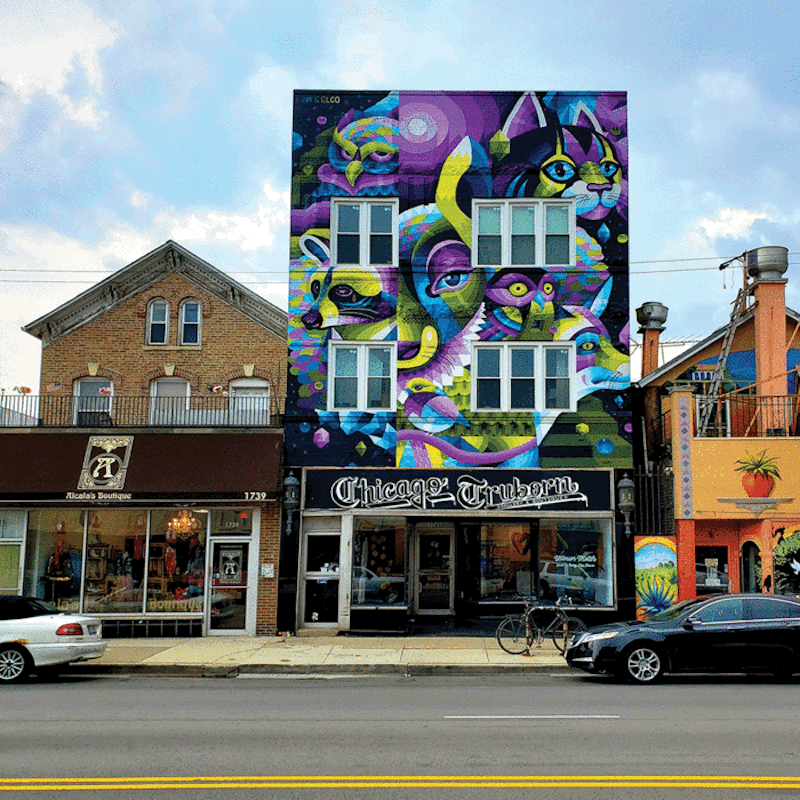Chicago Truborn: Sara Dulkin is a Dealer on a Welcome Mission


By JACQUELINE LEWIS
Thousands of people see Sara Dulkin in her gallery. Dulkin touts that she actively posts multiple times a day @CHICAGOTRUBORN as a way to promote artists as well as genuinely engage with her clients, fans and (more than 21K) followers. When she’s not posting Instagram reels, making clever time lapse videos, or cheekily rolling her eyes about how easy and affordable it is to buy art, she’s running an in-person space, an online storefront and a mural consultancy. Before social media consumed a large part of her day, Dulkin forged a relationship with Chicago as a city through its street art.
When I asked Dulkin, who opened Chicago Truborn in West Town years years earlier than other galleries did, how she decided to start the gallery she said it was in order to create a space for art in which she personally felt comfortable and where the art was affordable, a mission she continues today.
CGN: Tell us about how Chicago Truborn came to be?
Sara Dulkin: When I was a 20-something Columbia College student graffiti and street art helped me to better understand and connect with the city. The gallery itself arose because, as I was learning about art and attending galleries for the first time, I felt extremely intimidated in that particular type of space. Also when social media was just beginning, I was paying close attention to the tags and wheatpastes going up in Chicago. I became more familiar with what the artists creating them were doing and I was able to connect in person. Suddenly I was watching artists paint and getting an inside look at the entire process and culture. It didn’t take long before I realized graffiti and street art really wasn’t being represented here and honored in a gallery setting. At the same time I wanted to create a space that made sense for people like me – those who want to collect art, within financial reason!
In 2011 when I first started Chicago Truborn we were vending at street festivals and pop-up shows, utilizing other retail spaces. I used that time to meet artists and grow a collector base. In 2013 the gallery became an official brick-and-mortar storefront. The rest is history.
CGN: Chicago Truborn has been considered a sort of “anti” gallery. Can you explain what that means?
SD: The term “anti-gallery” was actually meant to encapsulate a feeling of community and inclusivity. In all of my previous experiences in galleries–whether it was self-inflicted or otherwise–I felt unwelcome (and often still do!). In most cases I barely even got a welcome nod, let alone any information on the exhibit. And I definitely couldn’t afford anything.
“Anti-gallery” is representative of a space that’s inviting and accessible–one that goes against standard norms. It’s everything a “traditional” gallery isn’t. No white walls, no price sheets, no pretense. Just come on in, enjoy yourself and fall in love with some art. We offer prints from $25, smaller artisan collectibles, even pins and sticker packs starting at $10. On average pieces here are going to be in the $350–$1,500 range. I really stress affordibility, and it’s one of Chicago Truborn’s core values. We have a special section on our website dedicated to art under $150.
No matter if you’re looking for a massive focal piece or just a small starter work, I want to help.
CGN: You have coined the phrase, “Become a Collector.” Do you have stories about new collectors where that term really made an impact?
SD: I have countless stories of first time customers who’ve evolved into die hard collectors. Over the last decade many, if not most, of my customers have similar stories to mine where they felt they could never afford art in galleries or, in some cases, had never visited one. It’s the most rewarding experience to be an integral part of someone’s journey as an art lover and a collector. It typically starts with something small, like a print. From there, via social media or frequent visits, our collectors are able to learn more about the artists they like while at the same time figuring out what they want their collection to look like. Price points become a bit less intimidating once a collector learns about the person and process behind the artwork. No matter what the entry point is, the result is they can’t wait to build their collection.
One story is about a Chicago collector who was vacationing in Mexico and got talking with a woman about a shared love of art and a subject that coincided with a show we were having. Through this encounter, a piece was purchased and shipped to Calgary to a new friend and collector. Word of mouth is just as valuable as an actual sale. This story really resonated with me and I am so grateful for the loyalty of my collectors.

CGN: Do you find that most of your sales are in person or virtual? How does Chicago Truborn handle both experiences for the collector?
SD: Throughout the last decade, the majority of our sales were in-person at the gallery. Opening nights are historically the busiest time for us. Of course since the pandemic everyone had to a pivot a bit. I’ve always been dedicated to building an online presence via social media, while also providing a seamless, easily navigated, online storefront. If you’re not providing your collectors the ability to purchase work online that’s clearly a missed opportunity. Before COVID we were 70/30 in-person/online, and now I would say we’re 50/50. I love the surge in online business. It’s incredible that this small gallery ships pieces all over the world. Utilizing social media continues to be a large part of my success; I can’t emphasize enough the importance of speaking to and connecting with your client base directly in that way.
CGN: How has your day to day business adapted since the onset of the pandemic?
SD: One common denominator between any small business who is lucky enough to have survived the pandemic is that, yes, changes were made! I started producing virtual openings immediately upon news of the shut downs. Our first virtual show was April 2020. I had my exhibitions already scheduled for the year, and my artists had worked so diligently creating all the work. I was determined to find a way to show it. By utilizing Matterport technology we were able to do a 3D scan of the gallery and provide an online experience that opened our doors to collectors all over the world. Viewers can actively participate in an exhibit however and whenever they see fit, zooming in on specific pieces, “walking” around the installation spaces, and even purchasing art through the tour. After two years I still continue to produce a virtual tour for each show (in addition to in-person). I’ve even received feedback from out-of-town artists who become interested in working with me solely based upon discovery of our virtual shows.

CGN: Tell me about Chicago Truborn’s work with so many muralists and local public art projects.
SD: Seeing as Chicago Truborn is dedicated to exclusively showing the work of street and graffiti artists, mural production has been a very natural progression. My artists love to paint big walls, and I love to make it happen. As a collector myself, I find it exciting to love a piece of public art and then be able to collect a piece or version of that artwork for my home. I’ve curated and produced dozens of murals over the last decade in Chicago. Our murals–some ephemeral, many permanent–can be found all over the city, from West Town and Lakeview to Evanston, Berwyn and beyond. One of my favorite murals can be seen on the facade of the gallery itself. In 2017 Eelco Van Den Berg painted a three-story piece on the building; it is still one of my favorite pieces in the city. I see people stopping to photograph it every single day.
CGN: What are some of the differences between managing gallery exhibitions and murals?
SD: Both are extremely hands-on, of course. The exhibitions in the gallery are always different, but the recipe is the same. I have a schedule and a groove that works for me. I know when I’ll be prepping the walls, when I’ll be hanging the work, when I’ll prepare the online catalogue.
When I’m preparing for a mural, there is a recipe too, but there are different factors at play. We’re examining wall textures and looking out for safety hazards like traffic and electrical lines. I’m arranging lifts and large amounts of paint –we’re usually battling with some type of extreme weather, from rain and snow to brutal heat. We’ve done it all. I’ve learned that there is no forcing anything, and that flexibility is the key to success.
At this point I have years of experience working with corporate entities as well as neighborhood groups and private commissions, and no wall is too big, or too small.
CGN: What is next for Chicago Truborn?
SD: I’m so pleased to share that Chicago Truborn’s 9 year anniversary show takes place this September. Although the gallery began in 2011, the actual storefront wasn’t opened until 2013. The anniversary show will feature nine artists near and dear to Chicago Truborn – artists who have played a significant role in our past, as well as a few who have debuts with the gallery in 2023. The opening spans two days, September 23 and 24, and coincides with the West Town Art Walk. Everyone can find details and a show lineup on our website and social media.
Chicago Truborn • 1741 W. Chicago Ave. (60622)






